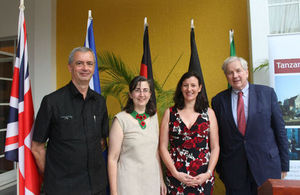When two bulls clash, the grass suffers: World War 1 in East Africa
Acting British High Commissioner, Penny Smith, hosted a talk with the German and Belgian Ambassadors to Tanzania, about the First World War in East Africa by visiting British academic Dr Anne Samson in Dar es Salaam on 23 July.

Acting British High Commissioner, Penny Smith with Dr. Anne Samson with German and Belgian Ambassadors to Tanzania
Few people are aware that the longest campaign of the First World War was fought over the territory which is today Tanzania, Rwanda and Burundi. Although the first shot and death of the war is attributed to Togoland, German East Africa, as the three territories (Tanzania, Rwanda, Burundi) were collectively known, was not far behind. Dar-es-Salaam was bombed from the sea on 8 August 1914 and a week later, 15 August 1914, 200 German and askari troops invaded British East Africa (Kenya) at the Holili/Taveta border. Here the first soldier in East Africa was killed, a corporal of the Maragoli tribe.
The war was fought on the land and on the water - Lakes Nyasa, Victoria and Tanganyika all saw action. MV Liemba, previously the German ship Graf von Gotzen and now 100 years old, was scuttled by the Germans to prevent it falling into British hands. There was action on the seas, HMS Pegasus was sunk in Zanzibar Harbour, and in the Rufiji Delta where the SMS Konigsberg was put out of action. Although there were no air battles, aeroplanes were used for sighting the enemy and dropping messages and bombs.
The war saw men from British East Africa, Congo, Uganda, Nyasaland (Malawi), Northern and Southern Rhodesia (Zambia and Zimbabwe), South Africa and the protectorates (Bechuanaland, Swaziland, Basotholand), Portuguese East Africa (Mozambique), India, Britain, Germany, Belgium, China, Sierra Leone, Gold Coast (Ghana), Nigeria, Seychelles, Gambia, Jamaica, Australia and America fight. Between 1914 and 1916, the fighting was mostly conducted by white and Indian troops whilst from 1916 to the end of the war, it was mostly black troops who fought. Over the period of the war, the German forces consisted of approx 3,000 whites and 12,000 black and Arab troops. They were opposed by approximately 126,972 British troops including white, Indian, black and Arab. Of these, 11,189 died during the war, whilst 10,811 were incapacitated by disease and wounds. More men died of disease and starvation than of battle wounds.
The German East Africa troops being the only force to occupy British territory in World War 1 were eventually pushed south into Portuguese East Africa in 1917 before they returned to German East Africa to invade Northern Rhodesia where they surrendered on 25 November 1918. The last battle on African soil was fought on 13 November 1918.
However, none of the soldiers would have achieved what they did without the work of the porters, carriers and labourers, many of whom were volunteered by their communities or were commandeered by the armies as the need arose. In all, it is estimated that over 1 million men served as porters, carriers and labourers in East Africa. Accurate numbers are difficult as some armies did not keep records. An estimated 95,000 black support service men died, the majority, 41,000 from German East Africa.
In addition to the supply of manpower, where men carried loads of up to 60 pounds, the German East African population provided all the fighting forces with food - initially paid for but later commandeered, and what was not eaten or carried away was burned to prevent the enemy getting it.
As the war came to an end, some of the worst droughts on record added to the shortage of food and this was made worse by the outbreak of influenza which resulted in more deaths than those during the war. It is estimated that four per cent of the population of East Africa died from the flu. The end of the war and the peace discussions war saw German East Africa split into British Tanganyika, Belgian Rwanda and Burundi. This led to further changes as new forms of administration were introduced.
Despite all the horrors of war, there were some positives: employment opportunities improved for some, the value of organisation became apparent and the mixing of cultures led to a sharing of ideas and knowledge which was to have an impact on the future political developments of all the territories involved.
About Anne Samson:
Anne is an independent historian and Co-ordinator of the Great War in Africa Association, an international group of people interested in the wars in Africa. She studied at Royal Holloway, University of London and is the author of ‘World I in Africa, The Forgotten Conflict Among the European Powers’, and ‘Britain, South Africa and East Africa Campaign, 1914-18: The Union Comes of Age’.